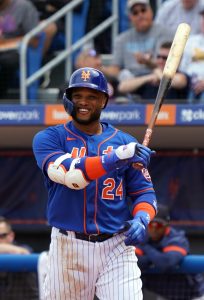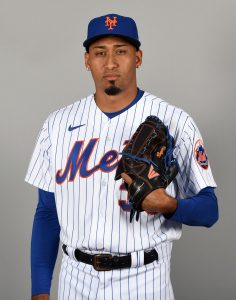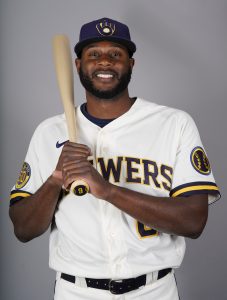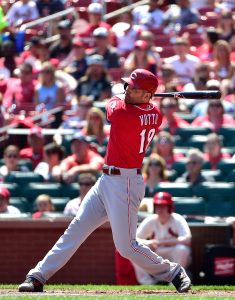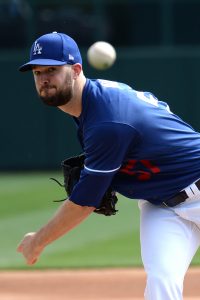Since joining the Athletics in 2016, Khris Davis has been a steady offensive force in the Oakland lineup, consistently finding his name near the top of yearly home run leaderboards. He hit more at least 42 homers in every year from 2016-2018 and played in at least 150 games each year. He even garnered MVP votes in 2017 and 2018, finishing eighth in the latter year when he slugged a league-leading 48 round-trippers. In April of last year, his reliability earned him a handsome two-year, $33.5MM extension that will keep him in an A’s uniform through at least 2021.
After that, however, things went south for Davis. All told, 2019 wound up being his worst year as a Major Leaguer, with his OPS dropping to just .679 and his wRC+ (81) dipping below league-average 100 for the first time in his career. And given that he doesn’t offer anything defensively, Davis’s value as a player is more sensitive to the fluctuations of his bat, and any slump becomes more pronounced. His value was always going to be limited to the offensive side—the A’s knew that when they signed him, but they couldn’t have foreseen such a sudden and steep fall from grace. But what was the root of his 2019 shortcomings, and what are the chances that Davis can right the ship in 2020 (whenever baseball does return) and be the slugger we’ve come to expect?
Beneath the surface, the striking difference between the 2019 version of Khris Davis and his previous years is that his exit velocity numbers slipped from elite to merely good. From 2016-2018, Davis’s first three years in Oakland, his average exit velocity ranked in the 94th percentile or better every year; in 2019, his 90.1 mph average placed him in only the top 30% of players. That’s still solid, no doubt, but for a player whose game is predicated almost entirely on power, that decline is considerably more significant. Davis has never been a batting average or OBP guy, so every tick off the exit velocity metric is important.
This worked against Davis in combination with a lessened ability to elevate the ball: along with the exit velocity numbers, Davis’s average launch angle on batted balls lowered from 18.1 to 13.2 degrees. Consequently, Davis saw his fly ball rate drop from 48.8% in 2018 to 37.4% last year, his lowest mark since 2013 when he was a Brewer. And of course, sacrificing fly balls comes with a corresponding jump in line drives and ground balls, which are markedly less valuable to a slugger like Davis—especially when he isn’t hitting the ball with as much authority as in years past.
Even when he did hit the ball in the air, he wasn’t doing as much damage as we’re used to seeing (which is even more unusual in 2019, given the league-wide power surge fueled by a jumpy baseball). And most of the drop-off came in a particular category: fly balls to the opposite field. Davis is a prolific opposite-field hitter, and it’s one of the traits that makes his power stand out; he hit 16 oppo homers in 2018 alone, more than anybody this side of J.D. Martinez. Last year, though, his wOBA on opposite-field fly balls was just .264, down from the astronomical .489 he posted the year prior. In essence, Khrush’s oppo power—a staple of his power game—became a non-factor, and anything in the air needed to be pulled.
As for his approach on a more micro scale, he swung the bat more than ever last year, especially at pitches in the zone: his 82.2% swing rate on pitches in the strike zone was the highest of his career, and his overall swing rate the second-highest. But Davis has lived in that neighborhood for his entire Athletics tenure, and it hasn’t stopped him from hitting in the past. Anyway, attacking hittable pitches is a good thing, and he doesn’t get exploited by going after too many bad pitches; his chase rate is just about league average. Moreover, that change hasn’t had any effect on his ability to make contact, and it hasn’t produced a precipitous change to either his walk or strikeout rate, which both sat right about where they were the year before.
So, what’s to blame for the sharp decline in production? It seems unlikely that a player in his early 30s, who just a year earlier mashed 48 home runs, could be sapped of his strength so suddenly. Career designated hitters like Nelson Cruz and Edwin Encarnación have maintained their pop into their late-30s; why should Davis be any different? It’d be more appropriate to chalk Davis’s struggles up to injuries: he was able to play in just 133 games for the A’s—the fewest in his Oakland tenure—and likely dealt with nagging consequences of oblique and hand injuries, both of which are notoriously troublesome for hitters. And it makes sense that with lingering hand problems, opposite field power would be one of the first things to go.
The oblique injury occurred in early May, while the hand issue dates to a HBP in late June. Sure enough, Davis’s three worst months in terms of OPS were July, August, and September. And trying to play through those injuries probably didn’t help things any. But with a full offseason (and more) to heal up the oblique and hand, the hope is that the Athletics will be able to count on a fully-healthy Davis to anchor the middle of their lineup for another postseason bid. The bet here is that Davis will be able to re-establish the consistent production he maintained for his first three years in Oakland.
The 2019 A’s were still able to succeed without much of the production they relied upon from Davis in 2018, thanks in part to the continued offensive maturation of Matt Chapman, Matt Olson, and Marcus Semien, as well as unexpected contributions from a host of low-profile hitters like Mark Canha. Their stout bullpen and patchwork rotation of misfits managed to prevent runs like the American League powerhouses, and with young guns A.J. Puk and Jesús Luzardo on hand and here to stay, they expect more of the same in 2020. Davis could be the missing ingredient to that equation, and another year of elite power output might make the difference between a third consecutive Wild Card exit and a deeper playoff run.

